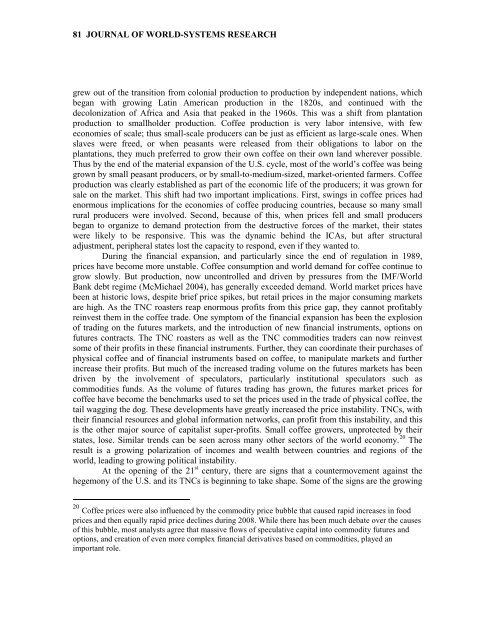Entire Volume 17 issue 1 - Journal of World-Systems Research ...
Entire Volume 17 issue 1 - Journal of World-Systems Research ...
Entire Volume 17 issue 1 - Journal of World-Systems Research ...
You also want an ePaper? Increase the reach of your titles
YUMPU automatically turns print PDFs into web optimized ePapers that Google loves.
81 JOURNAL OF WORLD-SYSTEMS RESEARCH<br />
grew out <strong>of</strong> the transition from colonial production to production by independent nations, which<br />
began with growing Latin American production in the 1820s, and continued with the<br />
decolonization <strong>of</strong> Africa and Asia that peaked in the 1960s. This was a shift from plantation<br />
production to smallholder production. C<strong>of</strong>fee production is very labor intensive, with few<br />
economies <strong>of</strong> scale; thus small-scale producers can be just as efficient as large-scale ones. When<br />
slaves were freed, or when peasants were released from their obligations to labor on the<br />
plantations, they much preferred to grow their own c<strong>of</strong>fee on their own land wherever possible.<br />
Thus by the end <strong>of</strong> the material expansion <strong>of</strong> the U.S. cycle, most <strong>of</strong> the world’s c<strong>of</strong>fee was being<br />
grown by small peasant producers, or by small-to-medium-sized, market-oriented farmers. C<strong>of</strong>fee<br />
production was clearly established as part <strong>of</strong> the economic life <strong>of</strong> the producers; it was grown for<br />
sale on the market. This shift had two important implications. First, swings in c<strong>of</strong>fee prices had<br />
enormous implications for the economies <strong>of</strong> c<strong>of</strong>fee producing countries, because so many small<br />
rural producers were involved. Second, because <strong>of</strong> this, when prices fell and small producers<br />
began to organize to demand protection from the destructive forces <strong>of</strong> the market, their states<br />
were likely to be responsive. This was the dynamic behind the ICAs, but after structural<br />
adjustment, peripheral states lost the capacity to respond, even if they wanted to.<br />
During the financial expansion, and particularly since the end <strong>of</strong> regulation in 1989,<br />
prices have become more unstable. C<strong>of</strong>fee consumption and world demand for c<strong>of</strong>fee continue to<br />
grow slowly. But production, now uncontrolled and driven by pressures from the IMF/<strong>World</strong><br />
Bank debt regime (McMichael 2004), has generally exceeded demand. <strong>World</strong> market prices have<br />
been at historic lows, despite brief price spikes, but retail prices in the major consuming markets<br />
are high. As the TNC roasters reap enormous pr<strong>of</strong>its from this price gap, they cannot pr<strong>of</strong>itably<br />
reinvest them in the c<strong>of</strong>fee trade. One symptom <strong>of</strong> the financial expansion has been the explosion<br />
<strong>of</strong> trading on the futures markets, and the introduction <strong>of</strong> new financial instruments, options on<br />
futures contracts. The TNC roasters as well as the TNC commodities traders can now reinvest<br />
some <strong>of</strong> their pr<strong>of</strong>its in these financial instruments. Further, they can coordinate their purchases <strong>of</strong><br />
physical c<strong>of</strong>fee and <strong>of</strong> financial instruments based on c<strong>of</strong>fee, to manipulate markets and further<br />
increase their pr<strong>of</strong>its. But much <strong>of</strong> the increased trading volume on the futures markets has been<br />
driven by the involvement <strong>of</strong> speculators, particularly institutional speculators such as<br />
commodities funds. As the volume <strong>of</strong> futures trading has grown, the futures market prices for<br />
c<strong>of</strong>fee have become the benchmarks used to set the prices used in the trade <strong>of</strong> physical c<strong>of</strong>fee, the<br />
tail wagging the dog. These developments have greatly increased the price instability. TNCs, with<br />
their financial resources and global information networks, can pr<strong>of</strong>it from this instability, and this<br />
is the other major source <strong>of</strong> capitalist super-pr<strong>of</strong>its. Small c<strong>of</strong>fee growers, unprotected by their<br />
states, lose. Similar trends can be seen across many other sectors <strong>of</strong> the world economy. 20<br />
The<br />
result is a growing polarization <strong>of</strong> incomes and wealth between countries and regions <strong>of</strong> the<br />
world, leading to growing political instability.<br />
At the opening <strong>of</strong> the 21 st century, there are signs that a countermovement against the<br />
hegemony <strong>of</strong> the U.S. and its TNCs is beginning to take shape. Some <strong>of</strong> the signs are the growing<br />
20 C<strong>of</strong>fee prices were also influenced by the commodity price bubble that caused rapid increases in food<br />
prices and then equally rapid price declines during 2008. While there has been much debate over the causes<br />
<strong>of</strong> this bubble, most analysts agree that massive flows <strong>of</strong> speculative capital into commodity futures and<br />
options, and creation <strong>of</strong> even more complex financial derivatives based on commodities, played an<br />
important role.





